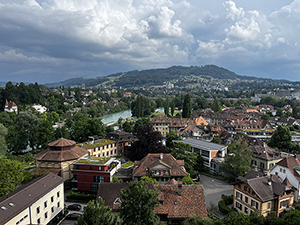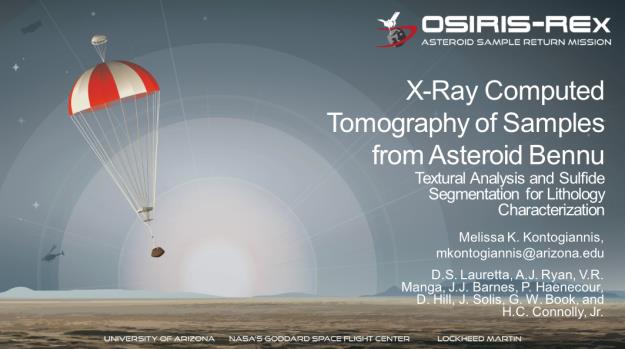The Shirley D. Curson Education Plus Fund in Planetary Sciences and LPL (formerly the Shandel Education Plus Fund) was established by Shirley Curson, a generous donor and friend of LPL, for the purpose of supporting travel expenses outside the state of Arizona during summer break. The award is open to students in the Department of Planetary Sciences and Lunar and Planetary Laboratory who propose to fund study, museum visits, special exhibits, seminars, instruction, competitions, research and other endeavors that are beyond those provided by the normal campus environment and are not part of the student’s regular curriculum during the recipient’s school year.
2024 Recipients: Roberto Aguilar, Namya Baijal, Melissa Kontogiannis
Roberto Aguilar Martinez
 The Curson Travel Award supported my participation in the 8th International Conference on Mars Polar Science and Exploration (Mars Polar Conference), which took place at the Kwanlin Dün Cultural Centre in Whitehorse, Yukon, Canada. This conference directly aligned with my research on the formation and evolution of glaciers on Mars and their potential as water resources for future human landing missions.
The Curson Travel Award supported my participation in the 8th International Conference on Mars Polar Science and Exploration (Mars Polar Conference), which took place at the Kwanlin Dün Cultural Centre in Whitehorse, Yukon, Canada. This conference directly aligned with my research on the formation and evolution of glaciers on Mars and their potential as water resources for future human landing missions.
At the conference, I delivered an oral presentation titled “New Insights on Internal Layering of Martian Mid-Latitude Glaciers with SHARAD.” My presentation focused on the use of orbital radar and high-resolution imagery to study internal climate signals within Martian glaciers. I received feedback from experts in the field, particularly those studying mid-latitude water ice deposits on Mars and terrestrial analogs. These discussions and connections contributed to my current work funded through a NASA FINESST grant.
SHARAD.” My presentation focused on the use of orbital radar and high-resolution imagery to study internal climate signals within Martian glaciers. I received feedback from experts in the field, particularly those studying mid-latitude water ice deposits on Mars and terrestrial analogs. These discussions and connections contributed to my current work funded through a NASA FINESST grant.
During the mid-conference field trip, we visited Kluane National Park and explored a rock glacier. This site is relevant to my research on terrestrial analogs and can potentially be a location to test the drone-based ground-penetrating radar that we are developing at LPL. I am grateful to the Curson Travel Award for enabling my participation in this conference, which not only advanced my current research but also facilitated meaningful professional connections within the Mars research community.
Namya Baijal
 The Curson Travel Award supported my travel to the University of Bern, Switzerland, this summer to attend a mentoring workshop and collaboration meeting associated with the NASA Psyche Mission. This mission is set to conduct the first in-situ investigation of a metal-rich asteroid, (16) Psyche, to answer the key question “Is Psyche the leftover core of a differentiated planetesimal, and if so, how did it form?” Using impact shock physics codes, we can simulate the formation of basin-forming impacts, as they are a diagnostic tool to probe the interior structure of Psyche and provide context about where the asteroid came from. My graduate research is centered around developing a testable hypothesis for Psyche’s collisional history and its observable surface geology for when the mission arrives.
The Curson Travel Award supported my travel to the University of Bern, Switzerland, this summer to attend a mentoring workshop and collaboration meeting associated with the NASA Psyche Mission. This mission is set to conduct the first in-situ investigation of a metal-rich asteroid, (16) Psyche, to answer the key question “Is Psyche the leftover core of a differentiated planetesimal, and if so, how did it form?” Using impact shock physics codes, we can simulate the formation of basin-forming impacts, as they are a diagnostic tool to probe the interior structure of Psyche and provide context about where the asteroid came from. My graduate research is centered around developing a testable hypothesis for Psyche’s collisional history and its observable surface geology for when the mission arrives.
To that end, I visited the University of Bern for one week to collaborate with Dr. Martin Jutzi and postdoctoral researchers Sabina Raducan and Alexandre Emsenhuber to enhance my understanding of the Bern Smoothed Particle Hydrodynamics (Bern SPH) code, our impact modelling tool of choice, and vital for my research as a student collaborator on the Psyche mission. Two parameters integral to modeling impact craters on Psyche are the ability to incorporate the realistic shape of the asteroid and interior porosity. Bern SPH is one of the few codes in the world with this unique capability, making this meeting an important opportunity for me to gain in-depth training on the codebase.
During the visit, I participated in detailed discussions with Drs. Jutzi, Raducan, and Emsenhuber, along with my advisor, Dr. Erik Asphaug, to develop unique ideas for the interior composition of Psyche. Although recent studies have confirmed that Psyche has a heterogeneous surface composition of mixed silicate-metal material, the interior structure of the asteroid is still unknown. In order to investigate variations in crater shape based on the asteroid’s interior, we formulated a new material to match Psyche’s overall density using the Tillotson Equation of State, which simulates the behavior of complex materials during hypervelocity impacts. I learned how to implement such features into the Bern SPH code from expert users, which allowed me to set up a new suite of simulations during that week. In addition, I was able to incorporate impact  parameters which were previously untested in this work, such as the role of impact angle in the collisions. Under the guidance of Dr Jutzi, I also gained expertise in developing high-level 3D graphical visualizations of our impacts on the Psyche target using a software called VAPOR. This tool has allowed me to easily map physical properties of interest such as porosity, density, and pressure onto a 3D isosurface of the asteroid and generate publication-style figures for my first manuscript on this work.
parameters which were previously untested in this work, such as the role of impact angle in the collisions. Under the guidance of Dr Jutzi, I also gained expertise in developing high-level 3D graphical visualizations of our impacts on the Psyche target using a software called VAPOR. This tool has allowed me to easily map physical properties of interest such as porosity, density, and pressure onto a 3D isosurface of the asteroid and generate publication-style figures for my first manuscript on this work.
This experience allowed me to conduct a wide range of impact models to simulate the formation of impact basins on Psyche over the summer, which I recently presented at the Psyche Team Meeting in Boston. With the help of this collaboration, I also advanced my knowledge of the Bern SPH code which I hope to creatively use in the future to solve problems pertaining to small bodies in our Solar System.
Melissa Kontogiannis
Travel to: Goldschmidt Conference in Chicago, Aug. 18-24, 2024
Although I was not able to travel to the Summer School for Sample Returns in France, as I’d originally planned when I received the Curson Travel Award, I am very grateful that I was able to use this award to support my travel to Chicago to present my research at the Goldschmidt Conference. My research is centered on the analysis of samples recently returned from asteroid Bennu by the OSIRIS-REx mission, with specific focus on the sulfide minerals these samples contain and what these minerals can reveal about the formation and alteration process Bennu may have experienced throughout its history. During my first year of graduate school, I mainly worked on X-ray Computed Tomography (XCT) analysis of 20 mm-scale asteroid samples. XCT is a powerful, non-destructive analytical technique, which is especially valuable in the analysis of precious and irreplaceable samples such as these asteroid materials, as it allows us to study the interior of a sample prior to any destructive or altering processes required for later analyses. Because these asteroid samples need to be cut/sectioned before any chemical analyses can take place, XCT data preserves the intact samples and provides likely the only complete picture of the sulfide populations they contain. The statistics of these sulfide population are important, as the distribution, orientation, and abundance of sulfide minerals can be used to compare different sample morphologies, determine particle density, and identify trends and broader features that may be evidence of hydrothermal alteration processes. I was able to use the XCT data I collected to perform statistical analyses of sulfide populations in 3 particles, and presented the preliminary results of this work during a 15-minute talk at the Goldschmidt Conference.
Presenting my research at the Goldschmidt Conference was a significant milestone in my research career, as it is the first time I have presented my work (in a poster or talk format) at an event outside the University of Arizona. Because Goldschmidt is a geochemistry-focused conference, presentations spanned numerous fields, including volcanism, tectonics, environmental/climate science, mineral resources and sustainability, ocean and atmospheric chemistry, and more, which not only gave me a chance to share my work with an audience that may not have been extensively familiar with planetary science research and its importance in the field of geochemistry, but also allowed me to learn about a variety of interesting topics in which I have very little background. Additionally, the conference hosted a variety of early-career focused events, through which I had the opportunity to meet graduate students from several other institutions and various research fields; these connections help to foster scientific interdisciplinarity and collaboration, which I am passionate about promoting.
This conference was a valuable opportunity to meet other early career scientists, learn more about the field of geochemistry beyond my own area of research, gain experience speaking at a conference, and share my work with the broader scientific community, so I am grateful for the support offered by the Curson Travel Grant that helped me to take advantage of this opportunity.
 |  |  |

